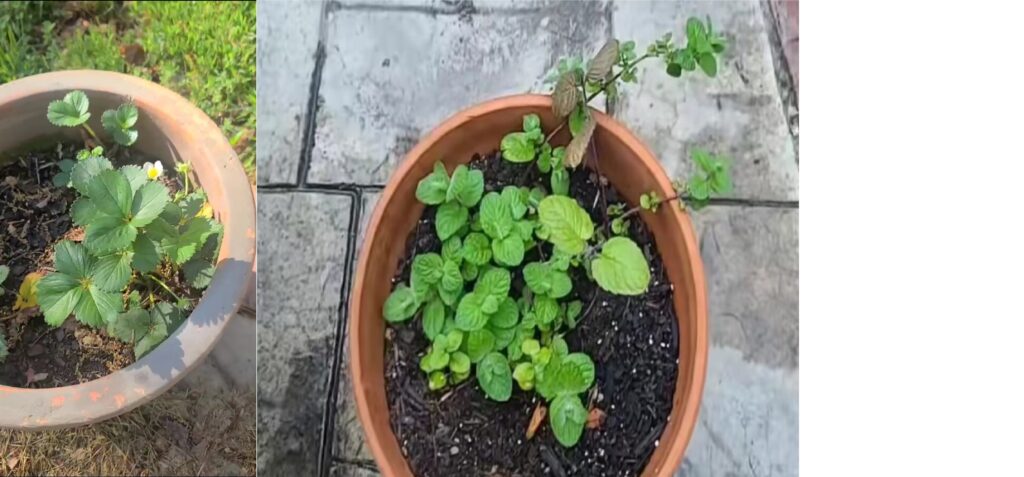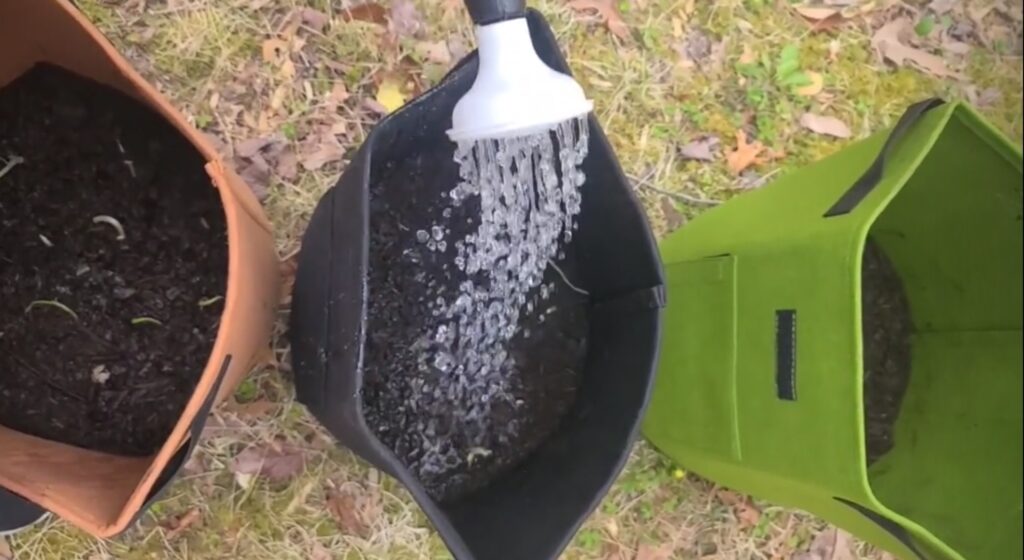
Once again I find myself adjusting my garden plans amidst my growing season. I had previously planned to use an area that has rich soil and great sunlight to make my new garden. But I underestimated the spacing between these trees and found myself once again scavenging for a new spot to make into my new growing space.

I could use the area I’d gardened in previously, but most of that is now a lovely little strawberry patch. The space left open is in the most shaded part of my yard and doesn’t provide enough space for this year’s gardening ambitions. So what’s a girl to do?
Well thankfully over the years I’ve grown a considerable collection of pots and grow bags just itching to be used. And while not everything can be grown in a pot, you’d be surprised how much you can produce in only a little bit of space!
Why container garden?
I’ve shared my reasons for container gardening: mainly due to faults in my initial plan. But container gardening is a great way to grow in whatever space you have. Containers can allow you to grow from the balcony of your apartment, the corner of your patio, or even on a sunny windowsill.
It opens a world of possibilities and can even make growing and harvesting some crops much easier than traditional gardening methods.

What grows well in pots?
A good place to start is knowing what to grow in pots. Not all plants thrive in a contained environment, as some plants require more space for their root systems than a typical pot can provide. When choosing varieties of different vegetables, look for bush or container varieties of plants, along with root vegetables. Some examples are:
- Broccoli
- Carrots
- Bush cucumber varieties
- Eggplant
- Lettuce
- Onions
- Peppers
- Radishes
- Spinach
- Tomatoes
- Zucchini
- Potatoes
Choosing the right container

Plastic
Plastic pots come in all sorts of shapes, colors, and sizes, and are pretty inexpensive, which makes them one of the most popular choices for container gardening and a great place to start for beginners. They are also relatively lightweight and hold in moisture well. While you could reuse the plastic pots or cups your plants were sold in at your local nursery, these tend to be very flimsy and break easily. I’ve found the plastic pots I’ve purchased also tend to break within a season or two of use.
Terra cotta (Ceramic)
Terra cotta pots are some of my favorites to grow in. They’re typically more decorative than plastic pots and since they are heavier they don’t get fall over as easily with larger plants. The clay is also porous which allows are and water to flow through it so the soil doesn’t stay overly wet. This also means they dry out more quickly than plastic pots and their weight can make the pots cumbersome to move around.
Grow bags
I am admittedly biased, but fabric pots are my favorite to grow in. They tend to be less expensive than terra cotta, sturdier than plastic, and allow a good amount of airflow and water saturation into the soil. On top of that most fabric pots have handles which makes them far easier to move around as needed than terra cotta pots. Some are even made for the purpose of root vegetables like potatoes, with a small fabric door on the side for easier harvesting. Unfortunately, this comes with the downside of the soil drying out much more quickly than plastic and terra cotta pots.

Container size
Fruiting vegetables like tomatoes (bush), eggplant, pepper, cucumbers, and beans should be planted in at least a five-gallon container so that they have room for their root systems and are less likely to make the container fall over. Rooted vegetables like beets and carrots or leafy vegetables like lettuce and kale can be planted in three-gallon containers to grow multiple plants in a compact space. Most culinary herbs and small rooted vegetables like radishes grow well in containers of one gallon or less.
Location
Most fruiting vegetables like tomatoes and peppers need full sun, which means providing at least six hours of direct sunlight each day. Try and place these containers facing southwest for optimal sun exposure.
Shade-loving plants like spinach, kale, and lettuce would do better in a slightly covered area like a porch or even near a north facing window inside. If you do not have any usable area that is shaded from the sun in the afternoon, try companion planting your cool weather vegetables near taller plants that can shade them during the hottest parts of the day.
When to plant
When gardening in the ground, most seeds prefer the soil to be between 50-60°F(10-15°C). I try to apply this same logic but to air temperature since my containers will be above the ground. So if direct sowing in outdoor pots, I try to wait until the temperatures at night are above 50-60° to prevent my plants from dying in a cold snap.
Care and maintenance
Soil
Using the right type of soil is important for the success of your container garden. I don’t recommend using garden soil for this, as it is more likely to compact making many become waterlogged. Try to use potting soil as this tends to be looser and has better drainage. If you can, source your soil from a local nursery.
Watering
Watering pots I’ve found can be a little finicky, as plants each have different requirements to thrive. Regardless of the stage your plants are in, keeping them watered consistently is key and watering them using the proper method yields the best results.
For shallowly planted seeds that are simply tamped into the surface or are just below, misting with water is better to get them started. Once plants have moved into pots, it’s best to stick with watering them from the bottom instead. This supports stronger more fibrous root systems and avoids getting mold on you plants leaves and fruit by simply watering it.
But how often should your pots be watered? A simple test that I like to use is to stick my finger about an inch into the soil. If the soil is still wet, then the plant doesn’t need to be watered. If the soil is dry, then that plant could use a drink. Often during the cooler spring months, watering once a day is fine. However, once the summer heat rolls in, some plants may need an extra watering here and there to keep them happy. Time your watering’s in the morning before the day’s temperature reaches its peak, and in the evening after it has started to cool down.
Conclusion
If you’re starting your own container garden this year, I hope this has helped you getting started. Gardens can come in all shapes and sizes. What are you growing this year?
Kayla Woodhull

I am a passionate gardener, baker and crafter. I love sharing my knowledge and experiences about growing produce, making recipes, and sharing my knitting, crocheting, and sewing projects. Developing a new hobby can seem daunting, and I hope to make getting started a little bit simpler.

